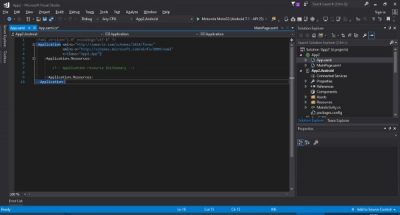

#UNIT TEST XAMARIN VISUAL STUDIO CODE#
but feel free to change the code to suit your object names etc. I’m going to assume you’ve used the same names as I have for the objects etc. If all goes well, within Test Explorer, you’ll see a single test class named UnitTest1 (unless you renamed this) and a single method TestMethod1 (unless you changed this). Select the menu item – Test | Run | Run All Tests. So before we write any code and to ensure all is working, feel free to run the tests… Both are DLL’s and the unit test project includes the code to run the tests via the Test Explorer. my MotorController project), press OK and OK again on Properties dialogĪt this point you should have two projects, one for your code and one for your unit tests. Press the Add New Reference button and check the project with code to be tested (i.e.Select Common Properties | Framework and References.Right mouse click on your unit test project and select Properties.Before we can test anything in the MotorController project we need to reference the project.Give the unit test project a name (mine’s MotorControllerTests), then press OK.

Select the Visual C++ | Test section and click on Native Unit Test Project.Select Add | New Project from the solution context menu.I’m not going to use MFC or ATL for this so leave them unchecked, then press Finish When the Win32 Application Wizard appears, press next then select DLL for Application Type, uncheck Security Development Lifecycle and check Export Symbols.Select Visual C++ Win32 Project and give it a name (mine’s named MotorController), then press OK.
 Open Visual Studio and create a New Project. Let’s start by creating a DLL for our library/code. Here’s the steps to get a couple of Visual Studio projects up and running, one being the code we want to test, the second being for the unit tests. Let’s jump straight in – my intention is to create a simple class which has some setter and getter methods (nothing special) and test the implementations, obviously this is just a simple example but it will cover some of the fundamentals (I hope). So why am I writing a post on this? Well I did encounter a couple of issues and felt it worth documenting those along with the “steps” I took to when using the Microsoft unit testing solution for C++ in Visual Studio. While it's unfortunate that it's not possible to test the binary that's actually being deployed to the iOS App Store (amework uses private APIs that will not pass the automated App Store acceptance tests) the influence of the library on the app will typically not show in the tests.Before I begin with this post, let me state that Unit testing native code with Test Explorer explains this topic very well. Due to more strict sandboxing on iOS, the Instrumentation Test Server needs to be integrated into the app in the form of the amework. For Android, the Instrumentation Test Server is deployed as a separate app. Operating the actual UI controls is accomplished through a Calabash component (Instrumentation Test Server) on the device or emulator that is controlled remotely by a test runner on the development machine or continuous integration server. To make things more complicated, I decided to test an Ionic/ Cordova hybrid app instead of a fully native or Xamarin C# app.Ĭalabash works for iOS and Android. NET background, I wanted to try the new Xamarin.UITest framework to write tests with C# and NUnit. Calabash tests are typically written using a combination of Ruby and Gherkin.
Open Visual Studio and create a New Project. Let’s start by creating a DLL for our library/code. Here’s the steps to get a couple of Visual Studio projects up and running, one being the code we want to test, the second being for the unit tests. Let’s jump straight in – my intention is to create a simple class which has some setter and getter methods (nothing special) and test the implementations, obviously this is just a simple example but it will cover some of the fundamentals (I hope). So why am I writing a post on this? Well I did encounter a couple of issues and felt it worth documenting those along with the “steps” I took to when using the Microsoft unit testing solution for C++ in Visual Studio. While it's unfortunate that it's not possible to test the binary that's actually being deployed to the iOS App Store (amework uses private APIs that will not pass the automated App Store acceptance tests) the influence of the library on the app will typically not show in the tests.Before I begin with this post, let me state that Unit testing native code with Test Explorer explains this topic very well. Due to more strict sandboxing on iOS, the Instrumentation Test Server needs to be integrated into the app in the form of the amework. For Android, the Instrumentation Test Server is deployed as a separate app. Operating the actual UI controls is accomplished through a Calabash component (Instrumentation Test Server) on the device or emulator that is controlled remotely by a test runner on the development machine or continuous integration server. To make things more complicated, I decided to test an Ionic/ Cordova hybrid app instead of a fully native or Xamarin C# app.Ĭalabash works for iOS and Android. NET background, I wanted to try the new Xamarin.UITest framework to write tests with C# and NUnit. Calabash tests are typically written using a combination of Ruby and Gherkin.







 0 kommentar(er)
0 kommentar(er)
